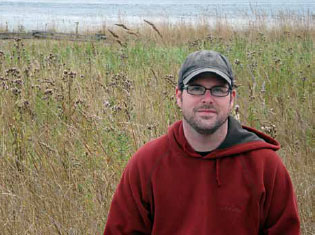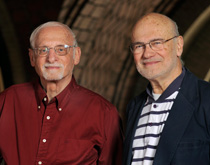Online exclusive: a second Last Word (click to read)
Lately, a lot of friends and family have asked, "How is your job—are you starving for work?" See, I work in the green homebuilding world, and the slowdown in the housing sector is widely publicized. Although it's definitely true that the industry at large is struggling, my response to this question is enthusiastic and honest: "I'm doing great!"

To be fair, I don't actually build homes—I work as a consultant in program design, education, and training—so I'm somewhat insulated. However, there has never been greater interest in green homebuilding, and the numbers don't lie. The U.S. Green Building Council's LEED for Homes program, a voluntary certification program, has seen participation grow to more than 10,000 homes in its first year, including 5,000 in the first quarter of 2009.
This level of interest makes sense from a business standpoint. When the market is strong, there is less motivation for builders to differentiate themselves; only in lean times do builders really compete for business. We also know that homebuyers want "green" homes, even if they're not always sure what it means. A director at Pulte Homes in Las Vegas recently told me that homes in their new development, which are 100% LEED-certified, have been selling at a rate of 100 times the market norm. He also raved that the free marketing and publicity from local media more than paid for the additional hard costs of upgrading the homes to earn certification. We've heard similar success stories from all across the country.
However, the business argument only explains so much. For every green home that is built, there are dozens of individuals who have proactively sought the education and training necessary to deliver that green home. There are parents who want to reduce their children's asthma attacks or affordable housing developers who want to keep energy bills low for their tenants. This is the human component, and this is where individual actions coalesce to become a green economic force that is both productive and fulfilling.
There is nothing peculiar or unique about homebuilding that makes this model unworkable in other industries. Companies in every corner of the economy have begun to explore the case for going green.
One of my favorite classes while at Carnegie Mellon was green chemistry with Terry Collins. The very concept of green chemistry seemed subversive–bringing a new paradigm to an old field and challenging those in it to do better. Professor Collins' work also emphasizes the point that the green economy should not be bound to solar panels and organic applesauce. And it's definitely not about recycling office paper and using Sigg water bottles. The green economy is about challenging our assumptions and inspiring the full intellect of each of us to make our respective industries healthier and more sustainable--whether we are architects designing efficient buildings, chemists identifying nontoxic alternatives, educators bringing sustainability concepts into the classrooms, or professionals working in fields that are seemingly outside the green spectrum. As someone immersed in this emerging green economy, I can tell you that there's no place I'd rather be.
—Douglas King (S'99, E'06)

Is "Zero Discharge" A Sensible Goal for Environmental Policy?
Francis C. McMichael and Joel A. Tarr
Carnegie Mellon University
On March 17, Don Hovey of the Pittsburgh Post Gazette wrote of the dilemma faced by Allegheny Energy in trying to be a 'zero discharge' plant. The utility is installing scrubbers in order to reduce smokestack admissions from its Hatfield Ferry coal fired power plant in Green County but wants to discharge a portion of the resulting scrubber waste water into the Monongahela river. Because the river is the source of drinking water for more than 90,000 residents of southwestern Pennsylvania, environmental groups such as Earthjustice are concerned that the utility is simply transferring emissions from one medium to another. The air may be cleaner, they say, but the water is dirtier.
In the past our region has faced similar issues regarding the transfer of pollutants from one place to another. For example, 1960s industrial waste textbooks recommended that local air pollution from coal burning could be reduced with tall stacks, but we learned eventually that while local conditions improved, acid rain was created in other localities. As late as the 1970s texts suggested that the best way to dispose of steel industry coke-making plant wastewater was to use it to cool red-hot coke pushed from ovens. This method of cooling coke, however, was actually a replacement for the approach used by the industry before the 1920s, when it had been discharged to local rivers. Complaints by citizens alerted water suppliers to the fact that phenols in the coke waste stream caused serious taste and odor problems in chlorinated water supplies and they urged zero discharge into water of taste and odor creating industrial emissions. Companies then shifted to quenching in order to avoid regulatory complications, as both Ohio and Pennsylvania passed laws prohibiting steel industry discharge of phenolics and cyanides to surface waters. But, that was not the end of the story.
In the mid-1970s, when air quality issues were paramount, the EPA, state government, the Allegheny County Health Department, and the courts, at the urging of the Group Against Smog and Pollution (GASP), moved to stop dirty water quenching as a serious threat to air quality and public health. The County wrote a clever environmental regulation that said in effect that "the steel industry may quench only with water that is suitable by permit for discharge to the nearest receiving stream," based on the fact that the Clean Water Act already mandated zero discharge into water by 1985. Zero is a very low number and sanitary and environmental engineers sometimes used zero as jargon when they knew they should have said "below level of detection." The Act, however, did not make that usage clear.
Chemical waste detection methods are better today than in the 1920s or the 1970s and environmental engineers are more careful about using the word zero. We must ask, however, what the proper goal of environmental management is? Does zero discharge mean complete containment or isolation if we encounter a substance with polluting potential? If so, in what media or environment? Setting a goal of zero emissions does not make scientific sense nor reflect critical thinking about pollution. Conservation of mass says we must be alert to the issue of moving materials from one media to another such as air to water, water to air, and or to land. Unless a substance can be isolated in a closed container we should expect that chemical equilibrium would partition chemicals proportionally between media that have open contact. Movement, however fast or slow, will happen at interfaces. As the relative concentration of a substance in a carrying media such as air and water decreases, it becomes more difficult to do separation. How much can be left behind? For instance, the 1972 Federal water pollution control amendments named 'heat to natural water ways' as a candidate for zero discharge but what the regulation did was drive emitters to reduce the size of cooling water outlets to rivers and to increase the use of large hyperbolic shaped cooling towers to discharge heat to the air. Heat had to go someplace.
As we think about these issues we need to redefine our goal as one of risk aversion based on public health criteria rather than on absolute standards such as zero discharge. Dedicated environmental groups may not find this as appealing as "zero discharge" but it promises more achievable and realistic goals of environmental quality.
Francis C. McMichael is Professor Emeritus in the Department of Civil and Environmental Engineering at CMU.
Joel A. Tarr is the Richard S. Caliguiri University Professor of History & Policy at CMU.



